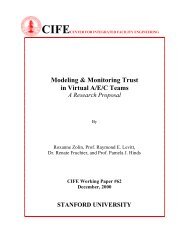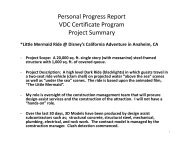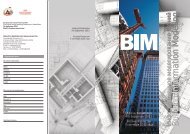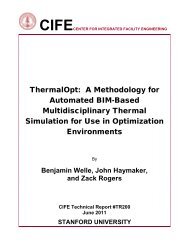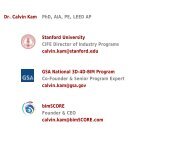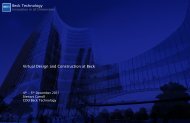Framework for Measuring Rationale Clarity of AEC Design Decisions
Framework for Measuring Rationale Clarity of AEC Design Decisions
Framework for Measuring Rationale Clarity of AEC Design Decisions
Create successful ePaper yourself
Turn your PDF publications into a flip-book with our unique Google optimized e-Paper software.
<strong>Framework</strong> <strong>for</strong> <strong>Measuring</strong> the <strong>Rationale</strong> <strong>Clarity</strong><br />
<strong>of</strong> <strong>AEC</strong> <strong>Design</strong> <strong>Decisions</strong><br />
John Marvin Chachere, Ph.D. 1 and John Riker Haymaker, Ph.D., AIA, LEED AP 2<br />
1 Consulting Assistant Pr<strong>of</strong>essor, Center <strong>for</strong> Integrated Facility Engineering, Department <strong>of</strong> Civil and Environmental<br />
Engineering, Stan<strong>for</strong>d University; Senior Computer Scientist, SGT Inc., NASA Ames Research Center, MS 269-1,<br />
M<strong>of</strong>fett Field, CA 94035 john.chachere@gmail.com<br />
2 Assistant Pr<strong>of</strong>essor, Center <strong>for</strong> Integrated Facility Engineering, Department <strong>of</strong> Civil and Environmental<br />
Engineering, Stan<strong>for</strong>d University, MC:4020 Stan<strong>for</strong>d, CA 94305 johnrhaymaker@gmail.com<br />
Abstract<br />
Current Architecture, Engineering, and Construction (<strong>AEC</strong>) design processes <strong>of</strong>ten rely on<br />
precedent to resolve complex decisions. However, changes to stakeholder concerns, design<br />
methods, and building products devalue much <strong>of</strong> this precedent knowledge. Project teams need<br />
to clearly communicate their decision rationale to develop consensus about design decisions.<br />
We review a broad range <strong>of</strong> relevant theory from decision-based design, decision analysis,<br />
decision theory, linguistics, logic, organization theory, and social welfare. We define rationale<br />
as a set <strong>of</strong> assertions regarding distinct components (i.e. managers, stakeholders, designers,<br />
gatekeepers, goals, constraints, alternatives, and analysis) that support design decisions. We<br />
define conditions <strong>of</strong> clarity (i.e. coherent, concrete, connected, consistent, credible, certain, and<br />
correct). We use these definitions to measure the clarity <strong>of</strong> assertions, components, and the<br />
rationale as a whole. Taken together, this <strong>Rationale</strong> <strong>Clarity</strong> <strong>Framework</strong> (RCF) provides a<br />
structured view that enables an objective evaluation <strong>of</strong> design decision methods.<br />
Keywords: design; decisions; rationale; management; project management; clarity; rationale<br />
clarity framework; decision making; design rationale<br />
©2010 John Chachere, John Haymaker




